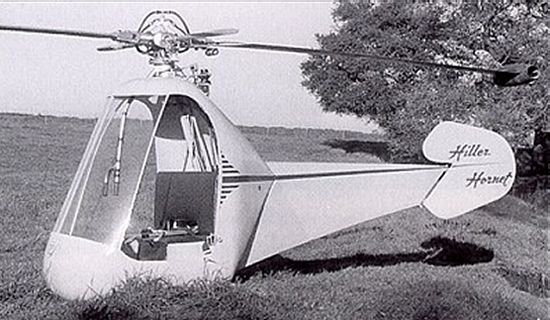| Picture |

|
| Manufacturer |
Hiller
|
| Type |
HJ-1 Hornet
|
| Introduced |
1/1/1951
|
| In production? |
No
|
| Units produced |
17
|
| Price US $ |
5,000.00
|
| Overall Length |
0 ft
|
| Length |
0 ft
|
| Height |
7 ft
|
| Width |
0 ft
|
| |
|
| |
|
| Description |
The YH-32 Hornet (aka HJ-1) was an ultralight helicopter built by the American Hiller Aircraft company. The Hornet is one of the earliest attempts at building a jet-powered helicopter. It took flight for the first time in 1950, four years later it was put into production.The Hornet had two seats and an incredibly simple construction. The craft consists of reinforced steel tubing overlaid with a fiberglass and plastic laminate skins.Power came from two Hiller 8RJ2B ramjets. These are installed on the rotor tips and directly drove the rotors. There was also a gasoline engine that served as a starter that would get the rotors to the required 50 RPM before the jets could be ignited.This design allowed for a helicopter that was incredibly light. Yet had 90 horsepower (67 kW) on tap. It also obviates the need for a tail rotor.The Hornet punched well above its size and weight, fueling hopes of military use, possible as a small gunship that today would be the equivalent of the MH-6 Little Bird. Unfortunately, the Hornet was true to its name in the sense that it was extremely noisy. It also suffered from a range that was too limited by the high fuel consumption of ramjet technology. Furthermore, the ramjet flames destroyed any hopes of low nighttime visibility. Ultimately only 18 were built and the project came to an end.
|
| Advertisement |
|
| Design features |
- Ramjets powered rotors eliminating transmission system and tailrotor
- Steel tube framework
- Fiberglass skin and plastic laminate
- Two Hiller 8RJ2B ramjets
- Auxiliary gasoline engine to turn the rotors prior to ignition of the ramjets
- Only two controls: Cyclic and collective-cum-rudder
|
|
The YH-32 Hornet (aka HJ-1) was an ultralight helicopter built by the American Hiller Aircraft company. The Hornet is one of the earliest attempts at building a jet-powered helicopter. It took flight for the first time in 1950, four years later it was put into production.The Hornet had two seats and an incredibly simple construction. The craft consists of reinforced steel tubing overlaid with a fiberglass and plastic laminate skins.Power came from two Hiller 8RJ2B ramjets. These are installed on the rotor tips and directly drove the rotors. There was also a gasoline engine that served as a starter that would get the rotors to the required 50 RPM before the jets could be ignited.This design allowed for a helicopter that was incredibly light. Yet had 90 horsepower (67 kW) on tap. It also obviates the need for a tail rotor.The Hornet punched well above its size and weight, fueling hopes of military use, possible as a small gunship that today would be the equivalent of the MH-6 Little Bird. Unfortunately, the Hornet was true to its name in the sense that it was extremely noisy. It also suffered from a range that was too limited by the high fuel consumption of ramjet technology. Furthermore, the ramjet flames destroyed any hopes of low nighttime visibility. Ultimately only 18 were built and the project came to an end.
|
|
- Advertisement -
|
Design features:
- Ramjets powered rotors eliminating transmission system and tailrotor
- Steel tube framework
- Fiberglass skin and plastic laminate
- Two Hiller 8RJ2B ramjets
- Auxiliary gasoline engine to turn the rotors prior to ignition of the ramjets
- Only two controls: Cyclic and collective-cum-rudder
|
| Persons |
2
|
| Max. Range |
31 mi
|
| Cruise Speed |
0 mph
|
| Max. Speed |
80 mph
|
| Max. rate of Climb |
0 ft/min
|
| HOGE ceiling |
0 ft
|
| Service Ceiling |
6890 ft
|
| Gross Weight |
1078 lb
|
| Empty Weigt |
542 lb
|
| Useful Load |
536 lb
|
| Fuel Capacity |
0 gallons
|
| Number of Engines |
2
|
| Engine Type |
Ramjet
|
| Engine Code |
Hiller 8RJ2B
|
| Horse Power |
|
| Rotorhead |
Teetering
|
| Number of rotorblades |
2
|
| Rotor Diameter |
23 ft
|
| Number of tail rotorblades |
0
|
| Tailrotor Diameter |
0 ft
|
|